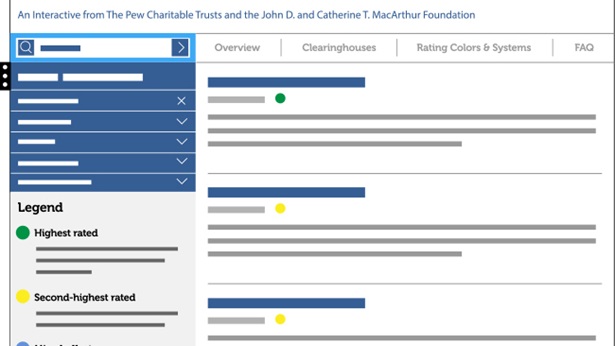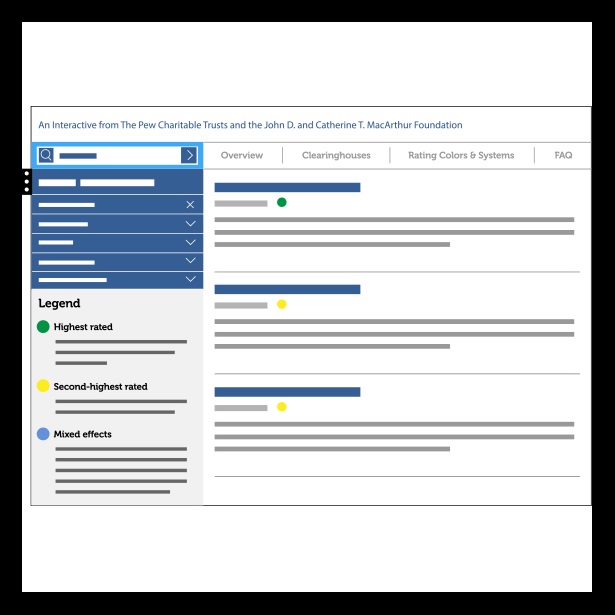Results First Improves Clearinghouse Database
Key changes include new search options, more program information

The Pew-MacArthur Results First Initiative recently released an enhanced version of the Clearinghouse Database, an online resource that brings together information on the effectiveness of social policy programs from several national clearinghouses. A noticeable change is a newly designed landing page where users can quickly access the search bar and find general information about the database, the clearinghouses, and the rating colors, as well as answers to frequently asked questions.
Other key changes include:
New search options
- The database can now search for a term in the program’s description, outcomes, target populations, ages, and settings, allowing users to look for programs by key characteristics instead of solely by name.
- Users can narrow their search by categories (which has replaced “policy area” and “intervention type”), settings (a new option), rating colors, and clearinghouses.
- The new search bar has a dropdown that auto-populates with up to 10 suggested programs so that users can access programs quickly and directly.
- When the initial search results are displayed, users will see a part of the clearinghouse’s description for each program.
More program information
- Along with ratings, the database now shows more program information from the clearinghouses’ websites, including description, outcomes, settings, target populations, and ages (where available), providing a broader snapshot of the program.
- The database now contains programs classified as having “insufficient evidence,” meaning that a clearinghouse has reviewed a program and found that there is not enough rigorous research to determine its impact. Although information on the program’s effectiveness is unavailable, the knowledge that programs have been reviewed and lack strong evidence is still valuable to the user.
Additional clearinghouses
- The database contains three additional clearinghouses: the U.S. Department of Health and Human Services’ Research-Tested Intervention Programs, which focuses on cancer control interventions in areas such as breast cancer screening, obesity, sun safety, and tobacco use; the U.S. Department of Health and Human Services’ Teen Pregnancy Prevention Evidence Review, which focuses on programs that reduce teen pregnancy, sexually transmitted infections, and associated sexual risk behaviors; and the University of Wisconsin Population Health Institute and Robert Wood Johnson Foundation’s County Health Rankings and Roadmaps’ What Works for Health, which rates the effectiveness of a broad variety of strategies (i.e., policies, programs, systems, and environmental changes) that can affect health through changes to behaviors, clinical care, social and economic factors, and the physical environment. Users now have access to information on hundreds of programs that focus mainly on public health.
In addition to these improvements, the database reflects a change in the name and sponsorship of the Coalition for Evidence-Based Policy, which has become the Laura and John Arnold Foundation’s Social Programs That Work. It no longer includes the Promising Practices Network, which ceased operations in June 2014, and What Works in Reentry, which was recently merged into CrimeSolutions.gov.
CrimeSolutions.gov re-reviewed all of the programs in What Works in Reentry using its methodology. This resulted in different ratings for some programs and no ratings for others when the available evidence did not meet CrimeSolutions.gov’s criteria.
Sara Dube is director, Karen Lyons is a manager, and Mara Weinstein is a principal associate with the Pew-MacArthur Results First Initiative.














